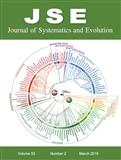Robert J. Soreng, Paul M. Peterson, Konstantin Romaschenko, Gerrit Davidse, Fernando O. Zuloaga, Emmet J. Judziewicz, Tarciso S. Filgueiras, Jerrold I. Davis, and Osvaldo Morrone
2015, 53 (2): 117–137
Based on recent molecular and morphological studies we present a modern worldwide phylogenetic classification of the ± 12074 grasses and place the 771 grass genera into 12 subfamilies (Anomochlooideae, Aristidoideae, Arundinoideae, Bambusoideae, Chloridoideae, Danthonioideae, Micraioideae, Oryzoideae, Panicoideae, Pharoideae, Puelioideae, and Pooideae), 6 supertribes (Andropogonodae, Arundinarodae, Bambusodae, Panicodae, Poodae, Triticodae), 51 tribes (Ampelodesmeae, Andropogoneae, Anomochloeae, Aristideae, Arundinarieae, Arundineae, Arundinelleae, Atractocarpeae, Bambuseae, Brachyelytreae, Brachypodieae, Bromeae, Brylkinieae, Centotheceae, Centropodieae, Chasmanthieae, Cynodonteae, Cyperochloeae, Danthonieae, Diarrheneae, Ehrharteae, Eragrostideae, Eriachneae, Guaduellieae, Gynerieae, Hubbardieae, Isachneae, Littledaleeae, Lygeeae, Meliceae, Micraireae, Molinieae, Nardeae, Olyreae, Oryzeae, Paniceae, Paspaleae, Phaenospermateae, Phareae, Phyllorachideae, Poeae, Steyermarkochloeae, Stipeae, Streptochaeteae, Streptogyneae, Thysanolaeneae, Triraphideae, Tristachyideae, Triticeae, Zeugiteae, and Zoysieae), and 80 subtribes (Aeluropodinae, Agrostidinae, Airinae, Ammochloinae, Andropogoninae, Anthephorinae, Anthistiriinae, Anthoxanthinae, Arthraxoninae, Arthropogoninae, Arthrostylidiinae, Arundinariinae, Aveninae, Bambusinae, Boivinellinae, Boutelouinae, Brizinae, Buergersiochloinae, Calothecinae, Cenchrinae, Chionachninae, Chusqueinae, Coicinae, Coleanthinae, Cotteinae, Cteniinae, Cynosurinae, Dactylidinae, Dichantheliinae, Dimeriinae, Duthieinae, Eleusininae, Eragrostidinae, Farragininae, Germainiinae, Gouiniinae, Guaduinae, Gymnopogoninae, Hickeliinae, Hilariinae, Holcinae, Hordeinae, Ischaeminae, Loliinae, Melinidinae, Melocanninae, Miliinae, Monanthochloinae, Muhlenbergiinae, Neurachninae, Olyrinae, Orcuttiinae, Oryzinae, Otachyriinae, Panicinae, Pappophorinae, Parapholiinae, Parianinae, Paspalinae, Perotidinae, Phalaridinae, Poinae, Racemobambosinae, Rottboelliinae, Saccharinae, Scleropogoninae, Scolochloinae, Sesleriinae, Sorghinae, Sporobolinae, Torreyochloinae, Traginae, Trichoneurinae, Triodiinae, Tripogoninae, Tripsacinae, Triticinae, Unioliinae, Zizaniinae, and Zoysiinae). In addition, we include a radial tree illustrating the hierarchical relationships among the subtribes, tribes, and subfamilies. We use the subfamilial name, Oryzoideae, over Ehrhartoideae because the latter was initially published as a misplaced rank, and we circumscribe Molinieae to include 13 Arundinoideae genera. The subtribe Calothecinae is newly described and the tribe Littledaleeae is new at that rank.










